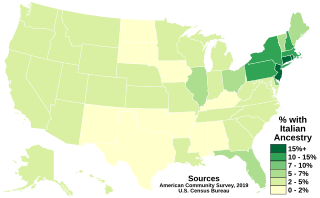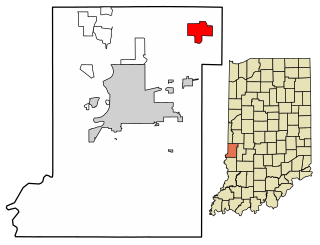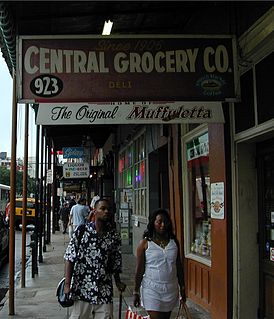
Boules is a collective name for a wide range of games similar to bowls and bocce in which the objective is to throw or roll heavy balls as close as possible to a small target ball, called the jack in English.

Collinsville is a city located mainly in Madison County, and partially in St. Clair County, both in Illinois. As of the 2010 census, the city had a population of 25,579, an increase from 24,707 in 2000. Collinsville is approximately 12 miles (19 km) from St. Louis, Missouri and is considered part of that city's Metro-East area. It is the site of the Brooks Catsup Bottle Water Tower, the world's largest ketchup bottle, it is the world's horseradish capital, and according to legend is home to the Gates of hell.

Clinton is a city in Clinton Township, Vermillion County, in the U.S. state of Indiana. The population was 4,893 at the 2010 census.

Italian Americans are citizens of the United States of America who are of Italian descent. The majority of Italian Americans reside in the urban Northeast and in urban industrial Midwestern metropolitan areas, with significant communities also residing in many other major US metropolitan areas.

Krebs is a city in Pittsburg County, Oklahoma, United States. The population was 2,053 at the 2010 census, a slight increase from 2,051 in 2000. Its nickname is "Little Italy." Krebs was founded before Oklahoma statehood as a coal-mining town in the Choctaw Nation of Indian Territory.

Scranton is the sixth-largest city in the Commonwealth of Pennsylvania. It is the county seat and largest city of Lackawanna County in Northeastern Pennsylvania's Wyoming Valley and hosts a federal court building for the United States District Court for the Middle District of Pennsylvania. With an estimated population in 2019 of 76,653, it is the largest city in northeastern Pennsylvania and the Scranton–Wilkes-Barre–Hazleton, PA Metropolitan Statistical Area, which has a population of about 570,000. The city is conventionally divided into nine districts: North Scranton, Southside, Westside, the Hill Section, Central City, Minooka, East Mountain, Providence, and Green Ridge, though these areas do not have legal status.

Helper is a city in Carbon County, Utah, United States, approximately 110 miles (180 km) southeast of Salt Lake City and 7 miles (11 km) northwest of the city of Price. It is known as the "Hub of Carbon County". The population was 2,201 at the 2010 census.

Roslyn is a city in Kittitas County, Washington, United States. The population was 893 at the 2010 census. Roslyn is located in the Cascade Mountains, about 80 miles east of Seattle. The town was founded in 1886 as a coal mining company town. During the 20th century, the town gradually transitioned away from coal, and today its economy is primarily based on forestry and tourism. The town was the filming location for The Runner Stumbles, Northern Exposure, and The Man in the High Castle. Many of the town's historical structures have been preserved, and its downtown was added to the National Register of Historic Places in 1978.

Little Italy, sometimes referred to as College Street West, is a district in Toronto, Ontario, Canada. It is known for its Italian Canadian restaurants and businesses. There is also a significant Latin-Canadian and Portuguese-Canadian community in the area. The district is centred on a restaurant/bar/shopping strip along College Street, centred on College Street, imprecisely between Harbord Street and Dundas Street, and spreading out east and west between Bathurst Street and Ossington Avenue. It is contained within the larger city-recognized neighbourhood of Palmerston-Little Italy.

The Coal Region is a historically important coal-mining area in Northeastern Pennsylvania in the central Ridge-and-valley Appalachian Mountains, comprising Lackawanna, Luzerne, Columbia, Carbon, Schuylkill, Northumberland, and the extreme northeast corner of Dauphin counties. Academics have made the distinction between the North Anthracite Coal Field and the South Anthracite Coal Field, the lower region bearing the further classification Anthracite Uplands in physical geology. The Southern Coal Region can be further broken into the Southeastern and Southwestern Coal Regions, with the divide between the Little Schuylkill and easternmost tributary of the Schuylkill River with the additional divide line from the Lehigh watershed extended through Barnesville the determining basins.

Little Italy is a neighborhood in Downtown San Diego, California, that was originally a predominately Italian and Portuguese fishing neighborhood. It has since been gentrified and is now a popular neighborhood full of Italian restaurants and grocery stores, home design stores, art galleries and residential units.

Little Italy, sometimes combined with University Village into one neighborhood, is on the Near West Side of Chicago, Illinois. The current boundaries of Little Italy are Ashland Avenue on the west and Interstate 90/94 on the east, the Eisenhower Expressway on the north and Roosevelt to the south. It lies between the east side of the University of Illinois at Chicago campus in the Illinois Medical District and the west side of the University of Illinois at Chicago campus. The community was once predominantly Italian immigrants but now is made up of diverse ethnic and socio-economic backgrounds as a result of immigration, urban renewal, gentrification and the growth of the resident student and faculty population of the University of Illinois at Chicago (UIC). Its Italian-American heritage is primarily evident in the Italian-American restaurants that once lined Taylor Street. The neighborhood is home to the National Italian American Sports Hall of Fame as well as the historic Roman Catholic churches Our Lady of Pompeii, Notre Dame de Chicago, and Holy Family.
The Westmoreland County coal strike of 1910–1911, or the Westmoreland coal miners' strike, was a strike by coal miners represented by the United Mine Workers of America. The strike is also known as the Slovak Strike because about 70 percent of the miners were Slovak immigrants. It began in Westmoreland County, Pennsylvania, on March 9, 1910, and ended on July 1, 1911. At its height, the strike encompassed 65 mines and 15,000 coal miners. Sixteen people were killed during the strike, nearly all of them striking miners or members of their families. The strike ended in defeat for the union.

Lodi is an unincorporated community in Liberty Township, Parke County, in the U.S. state of Indiana. Located on State Hwy 234, the most prominent feature is Waterman Baptist Church, which occupies a red brick building in the north-east corner of town. Just south of the town is one of the first round barns, the W. H. York Round Barn, which was built in 1895.

Fontanet is an unincorporated census-designated place in central Nevins Township, Vigo County, in the U.S. state of Indiana. It lies along Baldwin St., northeast of the city of Terre Haute, the county seat of Vigo County. Its elevation is 614 feet (187 m), and it is located at 39°34′34″N87°14′37″W. Although Fontanet is unincorporated, it has a post office, with the ZIP Code of 47851.
The Italian Cultural Centre is located at 3075 Slocan Street, in East Vancouver, Canada, on Slocan Street at Grandview Highway. The centre is noted to host a bar, multiple classrooms and various groups. Anna Foschi Ciampolini, as the coordinator, organized the conference at the centre that founded the Association of Italian-Canadian Writers. At its gate is a welded sculpture called Pagan by Italian sculptor Severino Trinca.

Jesse Woodson James was an American outlaw, bank and train robber, guerrilla, and leader of the James–Younger Gang. Raised in the "Little Dixie" area of western Missouri, James and his family maintained strong Southern sympathies. He and his brother Frank James joined pro-Confederate guerrillas known as "bushwhackers" operating in Missouri and Kansas during the American Civil War. As followers of William Quantrill and "Bloody Bill" Anderson, they were accused of committing atrocities against Union soldiers and civilian abolitionists, including the Centralia Massacre in 1864.

Italians have had a presence in the area since the explorations of the Europeans, Many Sicilians immigrated to New Orleans in the 19th century, traveling on the Palermo-New Orleans route by ship. The number of Italians who immigrated in the late 19th century greatly exceeded those who had come before the American Civil War. Only New York City has a higher population of Sicilian-Americans and Sicilian immigrants than New Orleans.
The Sunnyside Plantation was a former cotton plantation and is a historic site, located near Lake Village in Chicot County, Arkansas, in the Arkansas Delta region.

Sarah Wool Moore (1846–1911) was an artist and art teacher, as well as a language instructor, who was the first director of the Art Department at the University of Nebraska and founded the Nebraska Art Association. After leaving Nebraska, she taught in New York City. Disturbed by the intolerance shown to Italian immigrants, Moore worked as secretary of the New York Society for Italian Immigrants. In that capacity, she founded and taught at several language schools in New York and Pennsylvania to facilitate Italian immigrants learning of English. She also wrote English-Italian handbooks to help immigrants quickly learn the language they would use on a daily basis.

















